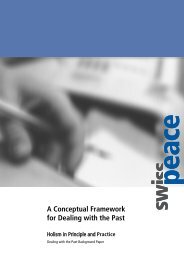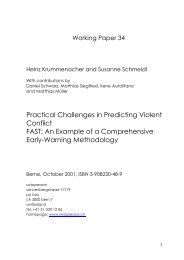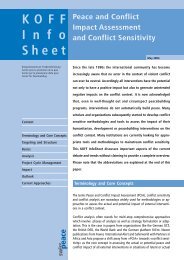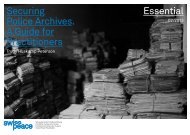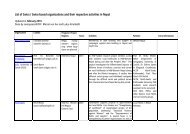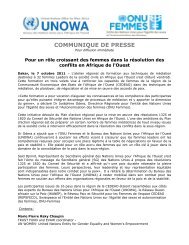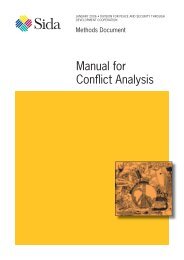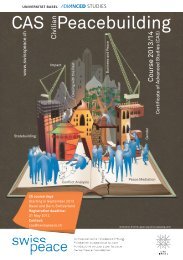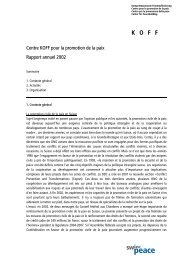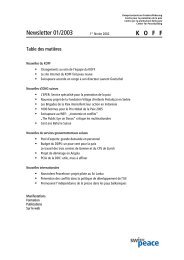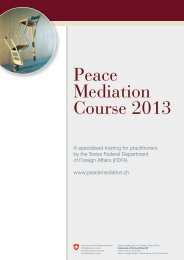Unpacking the Mystery of Mediation in African Peace ... - Swisspeace
Unpacking the Mystery of Mediation in African Peace ... - Swisspeace
Unpacking the Mystery of Mediation in African Peace ... - Swisspeace
You also want an ePaper? Increase the reach of your titles
YUMPU automatically turns print PDFs into web optimized ePapers that Google loves.
<strong>Mediation</strong> <strong>in</strong> <strong>African</strong> <strong>Peace</strong> Processes: Carefully Compar<strong>in</strong>g Apples and Oranges<br />
and all <strong>of</strong> <strong>the</strong>m were male. It seems that non-<br />
<strong>African</strong> chief mediators were only <strong>in</strong>volved <strong>in</strong><br />
some cases where <strong>the</strong> UN has <strong>the</strong> lead <strong>in</strong> <strong>the</strong><br />
peace process (e.g., Maarti Ahtisaari <strong>in</strong> Namibia<br />
<strong>in</strong> 1989, James Baker and Peter van Walsum <strong>in</strong><br />
Western Sahara), probably due to <strong>the</strong> global nature<br />
<strong>of</strong> <strong>the</strong> UN, where <strong>African</strong>s also play a role <strong>in</strong><br />
non-<strong>African</strong> conflicts. In most cases, however, a<br />
regional organization or neighbor<strong>in</strong>g state had <strong>the</strong><br />
lead and <strong>the</strong> chief mediator was an <strong>African</strong>,<br />
<strong>the</strong>reby highlight<strong>in</strong>g <strong>the</strong> idea that <strong>African</strong> problems<br />
have to be solved by <strong>African</strong>s.<br />
Mediators and experts beh<strong>in</strong>d <strong>the</strong> scenes: Besides<br />
<strong>the</strong> chief mediator, who carries <strong>the</strong> overall<br />
responsibility for <strong>the</strong> process and acts as <strong>the</strong> moral<br />
guarantor <strong>of</strong> <strong>the</strong> process, all cases <strong>in</strong>volved fur<strong>the</strong>r<br />
mediators, facilitators, and experts work<strong>in</strong>g beh<strong>in</strong>d<br />
<strong>the</strong> scenes. Often <strong>the</strong>ir role is geared more<br />
towards <strong>the</strong> details <strong>of</strong> <strong>the</strong> process such as moderat<strong>in</strong>g<br />
sessions and committees, draft<strong>in</strong>g documents<br />
as foundations for fur<strong>the</strong>r discussion, and<br />
<strong>in</strong> general help<strong>in</strong>g to design <strong>the</strong> process. Fur<strong>the</strong>rmore,<br />
experts on various topics were called <strong>in</strong><br />
to give advice to many <strong>of</strong> <strong>the</strong> longer processes,<br />
help<strong>in</strong>g to clarify tricky issues and br<strong>in</strong>g <strong>the</strong> parties<br />
to a level play<strong>in</strong>g field as regards knowledge<br />
relevant for <strong>the</strong> negotiations. Such support<strong>in</strong>g<br />
roles were played, <strong>in</strong> <strong>the</strong> Kenya negotiations, by<br />
<strong>the</strong> NGO Centre for Humanitarian Dialogue<br />
(HD), and <strong>in</strong> <strong>the</strong> Ivory Coast negotiations, by <strong>the</strong><br />
religious community <strong>of</strong> Sant’ Egidio. States <strong>of</strong>ten<br />
also provide experts to support peace processes.<br />
E.g., a Swiss mediator was <strong>in</strong>volved <strong>in</strong> <strong>the</strong> Burundi,<br />
Sudan North-South, Darfur, and Uganda-<br />
LRA negotiations. The UN was also <strong>in</strong>volved <strong>in</strong><br />
numerous ways <strong>in</strong> most <strong>of</strong> <strong>the</strong> cases we exam<strong>in</strong>ed,<br />
namely <strong>in</strong> <strong>the</strong> Sudan North-South, Darfur (after<br />
Abuja), Burundi, CAR, Western Sahara, and Uganda-LRA<br />
conflicts. The implementation <strong>of</strong> <strong>the</strong> Sudan<br />
North-South agreement would not have been<br />
possible without <strong>the</strong> UN. The fact that <strong>in</strong> most<br />
cases <strong>the</strong> lead mediator was an <strong>African</strong> did not<br />
prevent many o<strong>the</strong>rs from support<strong>in</strong>g <strong>the</strong> lead<br />
mediator with both human and f<strong>in</strong>ancial resources.<br />
<strong>Mediation</strong> style – comb<strong>in</strong><strong>in</strong>g facilitative and<br />
directive approaches: The literature on mediation<br />
<strong>in</strong>vestigates <strong>the</strong> extent to which various me-<br />
diation styles (e.g., facilitative, formulative, directive,<br />
manipulative) lead to different k<strong>in</strong>ds <strong>of</strong> mediation<br />
outcomes. Empirical studies seem to <strong>in</strong>dicate<br />
that manipulative mediation is more likely to<br />
lead to an agreement, while facilitative mediation<br />
is more likely to lead to longer-term tension reduction.<br />
11 It is very difficult, however, to label a<br />
peace process accord<strong>in</strong>g to <strong>the</strong>se three mediation<br />
styles, as most peace processes go through various<br />
phases dur<strong>in</strong>g which <strong>the</strong> form and style <strong>of</strong> mediation<br />
changes. The Ivory Coast Ouagadougou negotiations<br />
seem to be an example <strong>of</strong> <strong>the</strong> use <strong>of</strong> a<br />
predom<strong>in</strong>ately facilitative style that helped to create<br />
a breakthrough after more heavy-handed processes<br />
had failed. Burundi and Sudan North-South<br />
seem to be examples <strong>of</strong> both directive and nondirective<br />
mediation styles, depend<strong>in</strong>g on <strong>the</strong><br />
phase and issue. Both Nelson Mandela and K<strong>of</strong>i<br />
Annan used moral pressure to get <strong>the</strong> parties to<br />
overcome hurdles. In order to be successful, however,<br />
<strong>the</strong>se approaches have to be accepted by <strong>the</strong><br />
conflict parties.<br />
In some processes (e.g., Burundi, Congo/Kivu,<br />
North-Mali/North-Niger – Tuareg, Somalia Khartoum<br />
negotiations, and CAR pre-talks), f<strong>in</strong>ancial<br />
<strong>in</strong>centives <strong>in</strong> <strong>the</strong> form <strong>of</strong> per diems or possible future<br />
access to f<strong>in</strong>ances seemed to be an important<br />
<strong>in</strong>centive for <strong>the</strong> parties to attend. In many processes<br />
(e.g. Burundi, Sudan North-South), <strong>the</strong><br />
mediators formulated draft texts – <strong>of</strong>ten caus<strong>in</strong>g<br />
heated reactions from <strong>the</strong> parties. Never<strong>the</strong>less,<br />
by cont<strong>in</strong>u<strong>in</strong>g to work and adapt <strong>the</strong> draft, <strong>the</strong><br />
process moved ahead. James Baker used an approach<br />
that can be viewed as be<strong>in</strong>g formulative,<br />
as he drafted an agreement, but had no power to<br />
get <strong>the</strong> parties to sign or implement his plan. A<br />
draft peace agreement that can be changed by <strong>the</strong><br />
parties, but where <strong>the</strong>re is a deadl<strong>in</strong>e that imposes<br />
limitations on <strong>the</strong> scope for any adaptation, is<br />
practically <strong>the</strong> same as a “take it or leave it” text.<br />
It is questionable whe<strong>the</strong>r this constitutes mediation<br />
at all, or whe<strong>the</strong>r it is not <strong>in</strong>stead a form <strong>of</strong><br />
non-b<strong>in</strong>d<strong>in</strong>g arbitration. The same seems to apply<br />
to <strong>the</strong> f<strong>in</strong>al stages <strong>of</strong> <strong>the</strong> Darfur negotiations: <strong>the</strong><br />
document was drafted by <strong>the</strong> mediators; however,<br />
<strong>the</strong> parties had very little time to amend, adapt,<br />
or shape it <strong>in</strong> <strong>the</strong> way <strong>the</strong>y wanted, thus <strong>in</strong>dicat-<br />
11 Beardsley et al., 2006, op cit.<br />
17




